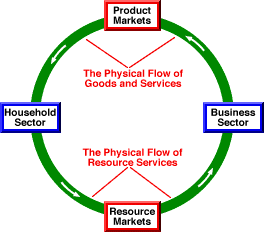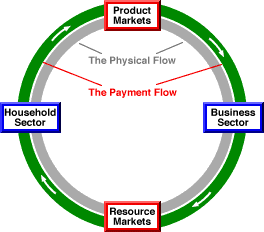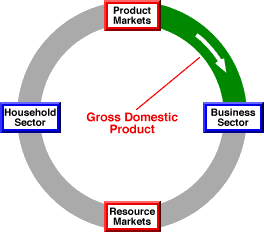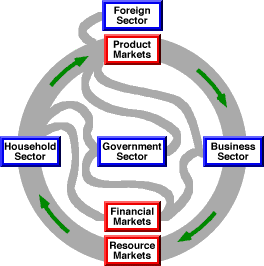
|
|
ADJUSTMENT, LONG-RUN AGGREGATE MARKET: Disequilibrium in the long-run aggregate market induces changes in the price level that restore equilibrium. If the price level is above the long-run equilibrium price level, economy-wide product market surpluses cause the price level to fall. If the price level is below the long-run equilibrium price level, economy-wide product market shortages cause the price level to rise. In both cases long-run equilibrium is restored. Price level changes induce changes in aggregate expenditures but NOT changes in real production. The reason is that long-run aggregate supply is full-employment real production, which is unaffected by the price level.
Visit the GLOSS*arama
|
|


|

|
                           CIRCULAR FLOW: A model of the continuous movement of production, income, and the services of scarce resources that flow between producers and consumers. In particular, the circular flow is a model of the continuous production and consumption interaction among the four major sectors of the macroeconomy--household, business, government, and foreign--using the three macroeconomic markets--product, resource, and financial. The circular flow model provides a easy way of getting the "big picture" and of seeing how the key parts of the macroeconomy fit together. The circular flow model is a fundamental representation of macroeconomic activity among the major players in the economy--consumers, producers, government, and the rest of the world. Different versions of the model sequentially combined the four sectors--household, business, government, and foreign--and the three markets--product, resource, and financial--into increasingly more comprehensive representations of the economy.The basic model illustrates the interaction between the household and business sectors through the product and resource markets. However, more realistic circular flow models include saving, investment, and investment borrowing enabled by the financial markets; taxes and expenditures of the government sector; and imports and exports of the foreign sector. The prime conclusion of the circular flow model is that the overall volume of the circular flow is largely unaffected by the path taken. In particular, household income can be used for consumption, saving, or taxes. The income diverting away from consumption and to saving or taxes does not disappear, but is used to finance investment by business sector and purchases by the government sector. Four SectorsThe circular flow model illustrates the interaction among the four macroeconomic sectors--household, business, government, and foreign. These four sectors capture four fundamental macroeconomic functions and their expenditures are combined together to purchase the economy's total production.- Household sector: This includes everyone, all people, seeking to satisfy unlimited wants and needs. This sector is responsible for consumption and undertakes consumption expenditures. It also owns all productive resources.
- Business sector: This includes the institutions (especially proprietorships, partnerships, and corporations) that undertake the task of combining resources to produce goods and services. This sector does the production. It also buys capital goods with investment expenditures.
- Government sector: This includes the ruling bodies of the federal, state, and local governments. Regulation is the prime function of the government sector, especially passing laws, collecting taxes, and forcing the other sectors to do what they would not do voluntarily. It buys a portion of domestic product',500,400)">gross domestic product as government purchases.
- Foreign sector: This includes everyone and everything (households, businesses, and governments) beyond the boundaries of the domestic economy. It buys exports produced by the domestic economy and produces imports purchased by the domestic economy, which are commonly combined into net exports (exports minus imports).
Three MarketsThe four macroeconomic sectors interact through three macroeconomic markets--product, resource, and financial. These three markets exchange the goods, services, and resources that are used for economic activity.- Product Markets: The product markets exchange the production of final goods and services, or what is termed gross domestic product. The buyers of this production are the four macroeconomic sectors--household, business, government, and foreign. The seller of this production is primarily the business sector.
- Resource Markets: The services of the four factors of production--labor, capital, land, and entrepreneurship--are traded through resource markets. Resource markets are used by the business sector to acquire the factor services needed for production. Payment for these factor services then generate the income received by the household sector, which owns the resources.
- Financial Markets: The commodity exchanged through financial markets is legal claims. Legal claims represent ownership of physical assets (capital and other goods). Because the exchange of legal claims involves the counter flow of income, those seeking to save income buy legal claims and those wanting to borrow income sell legal claims.
The Physical Flow| The Physical Flow |  |
The foundation of the circular flow is the physical movement of goods and services, what is termed the physical flow. This flow is illustrated in the exhibit to the right for the simplest circular flow model, two sectors (household and business) and two markets (product and resource). The physical flow is the movement of goods and services from the business sector to the household sector and the movement of resource services from the household sector to the business sector, usually represented as a counter-clockwise movement. For example, suppose that Duncan Thurly buys an OmniMotors XL GT 9000 Sports Coupe. This car physically "flows" from the OmniMotors Dealership in the business sector through the product markets and ends up in the possession of a member of the household sector, which is Duncan. This is represented by the upper half of the circular flow exhibit. In addition, the labor services of Gerald Cheverhold, an OmniMotors employee, physically "flows" from the household sector, where Gerald resides, through the factor markets, and ends up with OmniMotors in the business sector, where it is used in the production of an OmniMotors XL GT 9000 Sports Coupe. This is represented by the lower half of the circular flow exhibit. The Payment FlowThe physical flow of goods, services, and resources is countered by the payment flow that moves in the opposite direction. The payment flow is the movement of money payments from the household to the business sector in exchange for final goods and services and from the business to the household sector in exchange for the services of resources, usually represented as a clockwise movement.| The Payment Flow |  |
The basic payment flow is illustrated by the revised circular flow model to the left. The gray inner ring represents the physical flow. The green outer ring represents the payment flow moving in the opposite direction.For example, when Duncan purchases his OmniMotors XL GT 9000 Sports Coupe, the car "flows" from the dealer to him, from the business sector to the household sector in the upper half of the diagram. However, moving in the opposite direction is the payment for this car. The payment "flows" from Duncan to the dealer, from the household sector to the business sector. In the lower half of the diagram, the labor services of Gerald Cheverhold "flows" from the household sector to the business sector. However, moving in the opposite direction is the payment for this labor. The payment "flows" from OmniMotors to Gerald, from the business sector to the household sector. Four Measures| Four Circulating Measures |  |
The essence, the core, of the circular flow is the flow of payments between the household and business sectors through the product and resource markets. This core flow can be divided into four parts, each of which is important to the study of macroeconomics.- Gross domestic product, or GDP, is the upper right-hand segment of the flow. This is the revenue received by the business sector for the production of final goods and services sold to the household sector.
- Factor payments are the lower right-hand segment of the flow. These are wage, interest, rent, and profit payments made by the business sector to hire labor, capital, land, and entrepreneurship resources from the household sector.
- National Income is the lower left-hand segment of the flow. It is the income earned by the household sector for supplying labor, capital, land, and entrepreneurship resources to the business sector.
- Consumption expenditures are the upper left-hand segment. These are payments made by the household sector to purchase gross domestic product from the business sector.
Four Models| The Complete Model |  |
The circular flow model actually consists of four separate models, each sequentially adding sectors or markets and thus providing greater complexity and realism.- Two Sectors, Two Markets: The simplest circular flow model contains two sectors (household and business) and two markets (product and resource). This model highlights the core circular flow of production, income, and consumption.
- Two Sectors, Three Markets: A second version of the circular flow model adds the financial markets. This addition illustrates how saving is diverted from the household sector to the business sector to finance investment expenditures.
- Three Sectors, Three Markets: A third version of the model includes the government sector. This model highlights the importance of taxes, which are also diverted from household sector income and used to finance government purchases.
- Four Sectors, Three Markets: The most comprehensive circular flow model includes the foreign sector. Adding the foreign sector highlights the role of trade with the rest of the world, especially exports and imports.
The complete circular flow model, with all four macroeconomic sectors (household, business, government and foreign) and all three macroeconomic markets (product, resource, and financial), is presented in the above exhibit.

Recommended Citation:CIRCULAR FLOW, AmosWEB Encyclonomic WEB*pedia, http://www.AmosWEB.com, AmosWEB LLC, 2000-2025. [Accessed: July 18, 2025].
Check Out These Related Terms... | | | | | | |
Or For A Little Background... | | | | | | | | | |
And For Further Study... | | | | | | | | |
Search Again?
Back to the WEB*pedia
|



|

|
BLACK DISMALAPOD
[What's This?]
Today, you are likely to spend a great deal of time browsing about a thrift store seeking to buy either a genuine fake plastic Tiffany lamp or a microwave over that won't burn your popcorn. Be on the lookout for small children selling products door-to-door.
Your Complete Scope
This isn't me! What am I?
|

|
|
The earliest known use of paper currency was about 1270 in China during the rule of Kubla Khan.
|

|
|
"A winner is someone who recognizes his God-given talents, works his tail off to develop them into skills, and uses those skills to accomplish his goals. " -- Larry Bird, basketball player
|

|
IBB
International Bank Bonds
|

|
|
Tell us what you think about AmosWEB. Like what you see? Have suggestions for improvements? Let us know. Click the User Feedback link.
User Feedback
|


|


